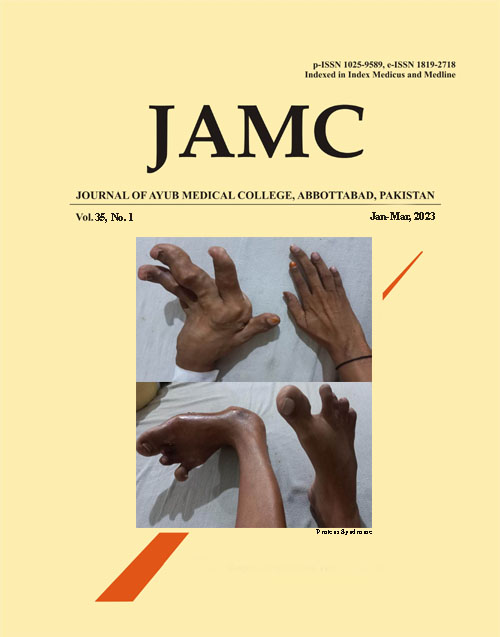NON-ALCOHOLIC FATTY LIVER DISEASE: PHYSICIAN’S WORST NIGHTMARE
DOI:
https://doi.org/10.55519/JAMC-01-11592Abstract
Fatty liver is nothing new when it comes to gastroenterology practice. In fact it is the most common finding on routine ultrasound scans while performing it for any other clinical indication. We do see a large number of patients having deranged liver function tests undergoing assessment by experienced physicians. Extensive workup is not futile and can add to the satisfaction of the doctor and patient concerned but sometimes it’s exhaustive. There has been a considerable advancement in management of NAFLD; it still remains physician’s worst nightmare especially when there is transformation to full blown cirrhosis and its devastating complications. Obesity, diabetes and hypertriglyceridemia are found inevitably with NAFLD forming metabolic syndrome do add fuel to the fire as far as treating such patients are concerned . They are integral parts of metabolic syndrome which itself can lead to disastrous complications. One of the most vital segments of NAFLD management is weight loss which doesn’t have to be vigorous rather a more steadfast approach with patience is needed. Convincing an obese patient for losing weight is a daunting task as his metabolic demands are entirely different from a normal weight or a thin lean individual. Distinction between Alcoholic Liver Disease and NALFD is not merely based on interpretation of liver function tests. The ALT and AST ratio does help but isn’t definitive. Many physicians do advise abstinence from alcohol as main treatment modality for alcoholic liver disease yet it becomes conspicuously difficult to manage them once the history of alcohol use is for decades. When nothing works, liver biopsy is a last resort showing classical pathological changes for both the diseases. That too requires experienced pathologist and sometime a second examination of the slide is needed as well. There is a need for multi-disciplinary approach for management NALFLD. There needs to be a close collaboration between hepatologist, dieticians and endocrinologists especially in case of metabolic syndrome. Non-alcoholic fatty liver disease (NAFLD) has quite high prevalence of about 25% in western countries. Patients at the greatest risk are those with obesity and type 2 diabetes mellitus. In 2019 the American Diabetes Association guidelines called, for the first time, for clinicians to screen for steato hepatitis and fibrosis all patients with type 2 diabetes and liver steatosis or abnormal plasma amino transferees. Merely screening isn’t enough. Rather more robust approach is required with target oriented results. The choice of treatment and sound clinical judgement will matter a lot. Weight loss in combination with antidiabetic drugs Iike pioglitazone have been found to reverse fibrosis and slow down the progression of disease. The role of vitamin E is also of paramount importance. The biggest dilemma is that patient with NALFD are symptomatic in the beginning with no clues whatsoever. Early diagnosis and treatment are the keys. It’s also mandatory for general physicians to refer the patients to gastroenterologists. NALFLD has raised a colossal uproar in the world over the last few years. Burnout NASH is another culprit that has raised alarms in the gastroenterology world. Being the 2nd most common cause of liver transplantation is a serious enough reason for all the medics in general and hepatologists to act vigilant and not be complacent about it.References
Devi J, Raees A, Butt AS. Redefining non-alcoholic fatty liver disease to metabolic associated fatty liver disease: Is this plausible? World J Hepatol 2022;14(1):158–67.
Hassen G, Singh A, Belete G, Jain N, De la Hoz I, Camacho-Leon GP, et al. Nonalcoholic Fatty Liver Disease: An Emerging Modern-Day Risk Factor for Cardiovascular Disease. Cureus. 2022;14(5):e25495.
Baynest HW. Classification, Pathophysiology, Diagnosis and Management of Diabetes Mellitus. J Diabetes Metab 2015;6(5):1–9.
Canbay A, Kälsch J, Neumann U, Rau M, Hohenester S, Baba HA, et al. Non-invasive assessment of NAFLD as systemic disease—A machine learning perspective. PLoS One 2019;14(3):1–15.
Spiers J, Brindley JH, Li W, Alazawi W. What’s new in non-alcoholic fatty liver disease? Frontline Gastroenterol 2022;13(e1):e102–8.
Romero-Gómez M, Zelber-Sagi S, Trenell M. Treatment of NAFLD with diet, physical activity and exercise. J Hepatol 2017;67(4):829–46.
Minich A, Arisar FAQ, Shaikh N ul S, Herman L, Azhie A, Orchanian-Cheff A, et al. Predictors of patient survival following liver transplant in non-alcoholic steatohepatitis: A systematic review and meta-analysis. EClinicalMedicine 2022;50:101534.
Published
Issue
Section
License
Copyright (c) 2023 Jibran Umar Ayub Khan, Ayesha Qaisar , Dur-e-Sameen

This work is licensed under a Creative Commons Attribution-NoDerivatives 4.0 International License.
Journal of Ayub Medical College, Abbottabad is an OPEN ACCESS JOURNAL which means that all content is FREELY available without charge to all users whether registered with the journal or not. The work published by J Ayub Med Coll Abbottabad is licensed and distributed under the creative commons License CC BY ND Attribution-NoDerivs. Material printed in this journal is OPEN to access, and are FREE for use in academic and research work with proper citation. J Ayub Med Coll Abbottabad accepts only original material for publication with the understanding that except for abstracts, no part of the data has been published or will be submitted for publication elsewhere before appearing in J Ayub Med Coll Abbottabad. The Editorial Board of J Ayub Med Coll Abbottabad makes every effort to ensure the accuracy and authenticity of material printed in J Ayub Med Coll Abbottabad. However, conclusions and statements expressed are views of the authors and do not reflect the opinion/policy of J Ayub Med Coll Abbottabad or the Editorial Board.
USERS are allowed to read, download, copy, distribute, print, search, or link to the full texts of the articles, or use them for any other lawful purpose, without asking prior permission from the publisher or the author. This is in accordance with the BOAI definition of open access.
AUTHORS retain the rights of free downloading/unlimited e-print of full text and sharing/disseminating the article without any restriction, by any means including twitter, scholarly collaboration networks such as ResearchGate, Academia.eu, and social media sites such as Twitter, LinkedIn, Google Scholar and any other professional or academic networking site.









